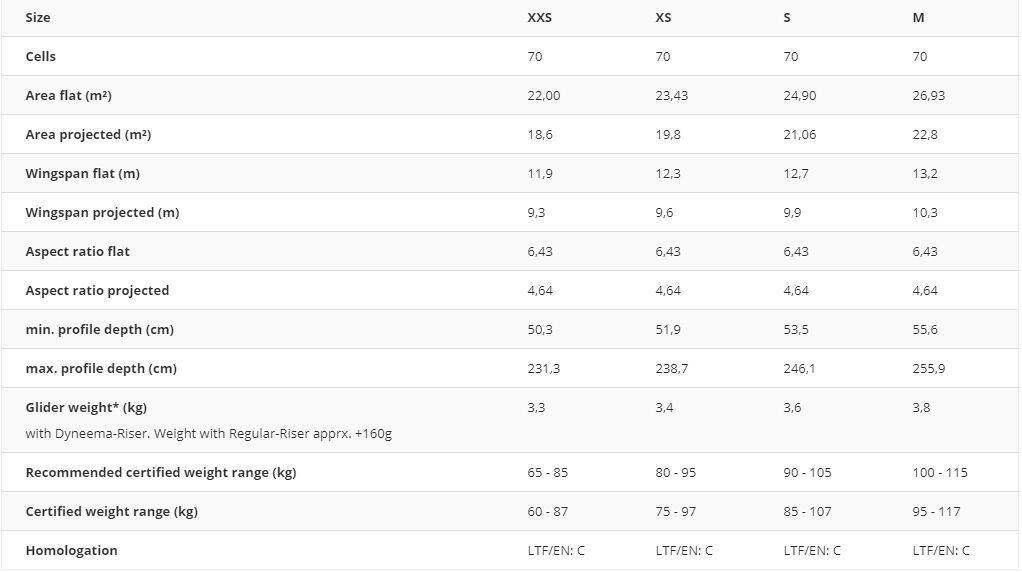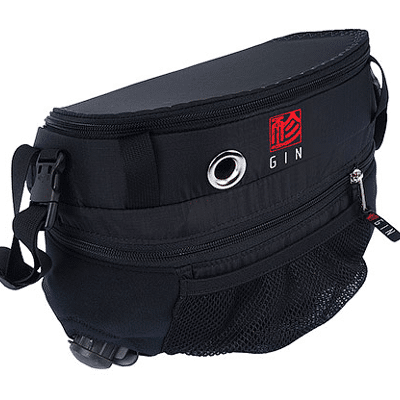Skywalk Spice 2
Ref. #1092
Sport class meets ultralight. The Spice2 is perfectly adapted to the needs of XC pilots who like to explore new terrain
Please complete your purchase or empty your basket before continuing.
was £0.00
Sport class meets ultralight.
The SPICE2 is pre-destined for performance-seeking cross-country hunters who like to optimize their XC gear down to the smallest detail in weight and packing size. At 3.3 to 3.8 kilograms, the four sizes of the XC sportster are record-breakingly light, and the latest innovations allow you to easily access its enormous performance potential. The SPICE2 feels solid in the air and can be flown very efficiently on bar via the SPEED CONTROL, making it one of the most powerful gliders in its class.
The wing is perfectly adapted to the needs of XC pilots who like to explore new terrain. The SPICE’s healthy balance gives you the confidence to solve tricky cross-country and bivouac flying situations at any time.
Sport Class Meets Ultralight.
The SPICE2 is pre-destined for performance-seeking cross-country hunters who like to optimize their XC gear down to the smallest detail in weight and packing size. At 3.3 to 3.8 kilograms, the four sizes of the XC sportster are record-breakingly light, and the latest innovations allow you to easily access its enormous performance potential. The SPICE2 feels solid in the air and can be flown very efficiently on bar via the SPEED CONTROL, making it one of the most powerful gliders in its class.
The wing is perfectly adapted to the needs of XC pilots who like to explore new terrain. The SPICE’s healthy balance gives you the confidence to solve tricky cross-country and bivouac flying situations at any time.
Tailor-made for explorers!
The best balance of performance and weight in the sport class.
How Does The Spice Fly?
The SPICE2 demonstrates its balanced characteristics right at launch. While kiting, the lightweight canopy rises steadily above the pilot and develops lift quickly, which makes launching from steep or tight sites in alpine terrain much easier.
In the air, the glider immediately conveys confidence, and the ultra-lightweight canopy provides pleasant feedback. For relaxed, fatigue-free XC flying, brake line pressure is pleasantly low and brake line travel is moderate. The glider responds directly to brake input and turns smoothly as bank angle increases. The SPICE2 is particularly pitch-stable and sits firmly in the air. This translates to an enormous performance boost, especially in turbulent conditions, and enables very efficient flying as the pilot compensates less for canopy movement around the vertical, horizontal or longitudinal axis when gliding.
The angle of attack of the canopy can be easily and efficiently controlled in accelerated flight via the C-risers. The speed system and the SPEED CONTROL work smoothly, so you can fly fast, fatigue-free and maintain a high average speed for a long time, even in turbulence –– perfect for demanding XC adventures!
Design
We have adamantly optimized the SPICE2 for lightness. At the leading edge, which is particularly stressed by UV radiation and mechanical influences, our innovative TX-Light material is used, which offers an excellent compromise between lightness and robustness.
The less stressed main parts of the top and bottom sails are made of very lightweight Dominico 10D material, which offers excellent aging resistance for its extremely low weight.
For the profile ribs and anchor lines, we use the proven Porcher Skytex 27g hard finish, which offers high dimensional stability at low weight.
The user-friendly line concept leaves nothing to be desired for an ultra-lightweight sports class glider.
Jet Flaps
- Our JET FLAPS extend the green arc as you approach the stall point, which substantially increases safety and also improves climb performance.
Riged Foil
- The Rigid Foil nylon wires on the leading edge help maintain its shape and ensure constant ram air pressure. Advantages: better takeoff behavior, more performance and lower canopy weight.
3D-Shaping
- A precise calculation of the leading edge geometry and the installation of an additional strip of fabric reduce wrinkling in this sensitive part of the glider. Advantages: exact wing shape, more performance.
3-Line-Levels
- The 3-line-level concept reduces the number of lines and the resulting drag. Advantages: more performance and a better overview at launch.
Mini Ribs
- Doubling the number of cells at the trailing edge increases its shape stability substantially. Advantage: fewer vortices improve the aerodynamics and with it the performance.
C-Wires
- Nylon wires sewn into the glider over the anchor points of the C-level lines. Advantages: better load distribution, reduced drag, more performance.
Shark Nose
- Together with a corresponding wing design, the shark nose technology improves pressure distribution in the canopy substantially. Advantages: much more solid flying feeling and substantial performance gain, especially when gliding on bar.
Speed Control
- Riser steering system which allows the pilot to even out turbulence, speed and pitch while flying on speed bar without having to release the speed bar.
Technical Data

Questions and Answers
What advantage does the SPEED CONTROL system offer?
With the SPEED CONTROL system you can compensate for turbulence while flying on bar, change your angle of attack, adjust your speed and make directional corrections without having to step out of the speed bar. This enables a very efficient and fast flying style. The SPEED CONTROL steers the C and B lines simultaneously to avoid performance decreasing deformation of the glider, which would happen if you only pulled on the C-lines.
What do I have to take care of when using the SPEED CONTROL?
The SPEED CONTROL may only be actuated to such an extent that the line shackles of the C-lines are not pulled further than the line shackles of the A-lines.
Make absolutely sure not to pull down the C-risers individually, but instead pull down both equally.
At trim speed the SPEED CONTROL may only be used as emergency control, under no circumstances does the SPEED CONTROL replace the brake handles.
Is the deterioration on light-cloths higher than on a regular glider cloth?
Light-cloths are thinner than conventional glider-cloths and therefore less resistant against mechanical strain. That means you need to pay more attention on small rocks and bushes. Please avoid any unnecessary contact to the ground. With this strict observance you will have the same durability as with a conventional glider-cloth.
What are the glide ratio (L/D), trim and maximum speeds?
We know that these data are interesting for you as a pilot, but for us to publish them would be a bad idea for the following reasons:
- Performance data are highly dependent on the drag of the pilot and are thefore related to sitting position and harness. The difference between aerodynamically favorable and unfavorable harnesses and sitting positions can be as much as a whole L/D number.
- Performance increases with the size of the glider. A large glider will always outperform the same glider in a smaller size. So a question about the performance of a glider is always also a question about the size.
- There is no normed method of testing the performance of paragliders. For example, speed varies with altitude and the associated different air pressure, but also with the total weight of the system.That means that there simply isn’t THE speed or THE L/D that would allow a serious comparison with another glider. Performance data are dependent on the harness, the size of the glider, on the air mass and the total weight.
How do I calculate my takeoff weight?
Takeoff weight is calculated by adding the weight of the pilot including clothes to the weight of the equipment. The equipment consists of the harness, the reserve chute, the paraglider itself, and any flight instruments and other baggage you may carry (e.g. rucksack, etc.).
Is it OK for me to shorten the brake lines on my skywalk paraglider?
Changing the length of the brake lines can have a negative effect on the flying characteristics and extreme flight behavior. The paraglider needs a little more lead when flying on speed bar, otherwise the glider could be braked unintentionally, leading to a loss of performance. When performing extreme flying maneuvers, shortening the brake lines too much can cause complications during recovery from collapses, parachutal stall, etc.
Am I allowed to make modifciations to my skywalk paraglider?
No, because the glider is certified the way it is delivered to you. Even the brake line length is part of the trim and must not be changed.
Do the nylon wires in the glider need any special attention or packing method?
Our nylon wires are flexible and kink resistant, so they won’t break under normal circumstances. But due to the packing volume it is a good idea to lay the Rigid Foils in the leading on top of each other on both sides.
What are JetFlaps and how do they work?
Jet Flaps are a so-called split flap like those seen on a large airplane. When the glider is braked, the airflow is routed through the glider, restoring smooth airflow. This extends brake line travel and softens the stall behavior.
What advantage do the JetFlaps on my skywalk paraglider offer?
Lower flyable minimum airspeed. The speed range is wider and easier to control. The pilot has more time to react when flying near the stall point.
Your SPICE2 Package
 The ultralight xc sportster comes with:
The ultralight xc sportster comes with:1x Glider backpack ALPINE (or HIKE*)
1x Compression strap
1x Innerbag for glider
1x Riser bag
1x BASIC GUIDE
1x Bandana
1x Self-adhesive repair patch
Spice2_Pro_Guide
Click here to download 1.12 MB - pdf
Related

Gin Flightdeck Race 5 litre
£84.00
€99.96













